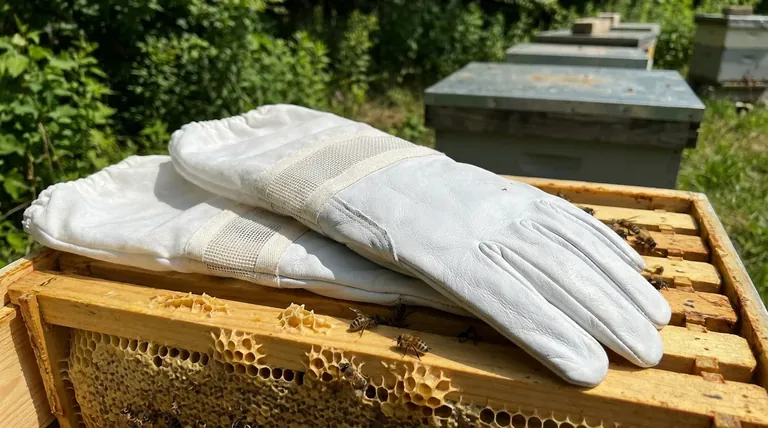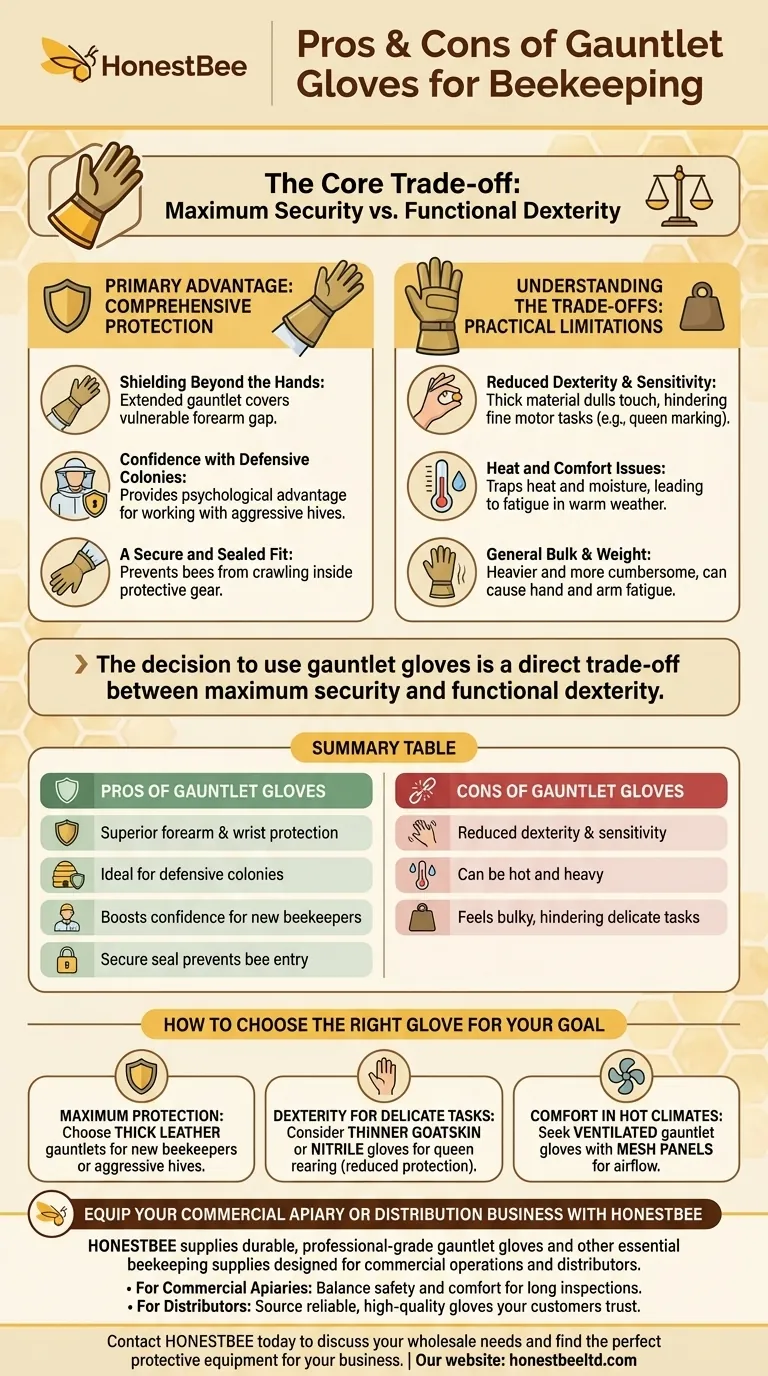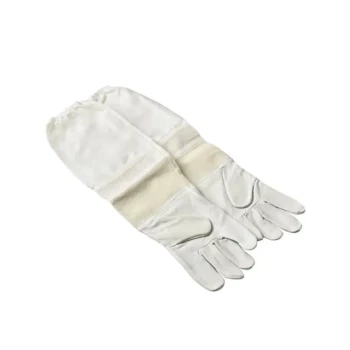The primary benefit of gauntlet gloves for beekeeping is superior protection that extends up the forearm, making them ideal for handling defensive colonies or for new beekeepers seeking maximum confidence. However, this enhanced safety comes with significant trade-offs, namely a reduction in dexterity, increased heat and weight, and a general feeling of bulkiness that can hinder delicate tasks.
The decision to use gauntlet gloves is a direct trade-off between maximum security and functional dexterity. While they provide the best defense against stings, their thickness and size can make sensitive hive manipulations more challenging.

The Primary Advantage: Comprehensive Protection
Gauntlet-style gloves are the standard for a reason: they are designed to minimize the risk of stings in the most vulnerable areas. This comprehensive coverage is their defining feature.
Shielding Beyond the Hands
The extended sleeve, or "gauntlet," is the key benefit. It covers the vulnerable gap between a shorter glove and the cuff of your bee suit or jacket, an area bees often target.
Confidence with Defensive Colonies
This added protection provides a significant psychological advantage. Knowing your hands and arms are well-shielded allows you to work more calmly and confidently, which is essential when inspecting a more aggressive or "hot" hive.
A Secure and Sealed Fit
Most gauntlet gloves are designed to be worn first, with the sleeve of the bee suit pulled over the top. This, often combined with an elastic cuff, creates a secure seal that prevents bees from crawling inside your protective gear.
Understanding the Trade-offs
While gauntlets excel at protection, they introduce practical limitations that every beekeeper must consider. These trade-offs become more apparent the more you handle your bees.
Reduced Dexterity and Sensitivity
This is the most significant drawback. The thick leather or cotton material that protects you from stings also dulls your sense of touch. Tasks requiring fine motor skills, like marking a queen, picking up a single bee, or carefully separating frames, become much more difficult.
Heat and Comfort Issues
The heavy material and extended coverage trap heat and moisture. In warm weather, gauntlet gloves can become uncomfortably hot and sweaty, leading to fatigue during longer hive inspections, especially if they are not the ventilated type.
General Bulk and Weight
Compared to alternatives like goatskin or nitrile gloves, gauntlets are noticeably heavier and more cumbersome. This can contribute to a feeling of being disconnected from your work and can fatigue your hands and arms over time.
How to Choose the Right Glove for Your Goal
The best glove is not a one-size-fits-all solution; it's about matching the tool to your specific needs, hive temperament, and personal comfort level.
- If your primary focus is maximum protection and confidence: Gauntlet gloves made of thick leather are the definitive choice, especially for new beekeepers or those with known aggressive hives.
- If your primary focus is dexterity for delicate tasks: Consider thinner goatskin gauntlets or even disposable nitrile gloves worn over a thin liner for tasks like queen rearing, but be aware of the reduced protection.
- If your primary focus is comfort in hot climates: Seek out ventilated gauntlet gloves, which incorporate mesh panels to improve airflow without significantly compromising safety.
Ultimately, choosing the right glove empowers you to work with your bees safely, confidently, and effectively.
Summary Table:
| Pros of Gauntlet Gloves | Cons of Gauntlet Gloves |
|---|---|
| Superior forearm & wrist protection | Reduced dexterity & sensitivity |
| Ideal for defensive colonies | Can be hot and heavy |
| Boosts confidence for new beekeepers | Feels bulky, hindering delicate tasks |
| Secure seal prevents bee entry |
Equip your commercial apiary or distribution business with the right protection.
Choosing the correct beekeeping gloves is crucial for safety and efficiency. HONESTBEE supplies durable, professional-grade gauntlet gloves and other essential beekeeping supplies designed for the demands of commercial operations and distributors.
Let us help you optimize your safety gear:
- For Commercial Apiaries: Protect your team with gloves that balance maximum safety and practical comfort for long hive inspections.
- For Distributors: Source reliable, high-quality gloves your customers trust.
Contact HONESTBEE today to discuss your wholesale needs and find the perfect protective equipment for your business.
Visual Guide

Related Products
- Goatskin Leather Beekeeper Gloves with Vent Long Sleeve for Beekeeping Honey Bee Sting Proof Protection
- Goat Skin Leather Bee Sting Proof Beekeeping Gloves with Canvas Sleeve
- Mesh Ventilated 3 Layer Goatskin Beekeepers Gloves for Beekeeping
- Professional Beekeeping Suit for Kids and Girls Childrens Bee Keeper Suit
- Professional Drop-Style Hive Handles for Beekeeping
People Also Ask
- What should be considered when selecting beekeeping gloves? Find the Perfect Fit for Safety & Dexterity
- Which type of gloves provide the most sting resistance? The Definitive Guide to Beekeeping Hand Protection
- What is the importance of choosing the right gloves for beekeeping? Balance Protection and Dexterity for Hive Success
- What are the features of beekeeping gloves? Balancing Protection & Dexterity for Your Hives
- What should beginner beekeepers consider when choosing beekeeping gloves? Balance Protection and Dexterity for Success



















